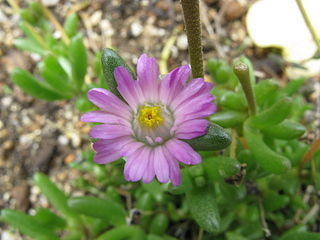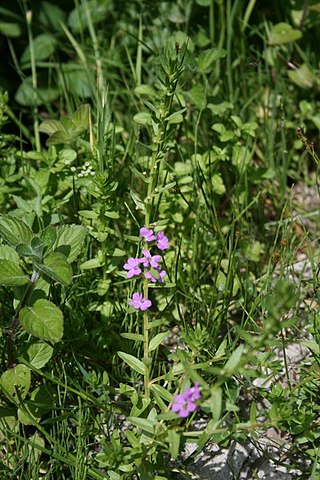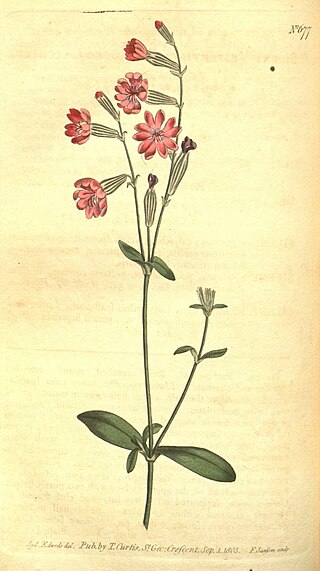
Campanula carpatica, the tussock bellflower or Carpathian harebell, is a species of flowering plant in the family Campanulaceae.

Lampranthus is a genus of succulent plants in the family Aizoaceae, indigenous to southern Africa.

Festuca rubra is a species of grass known by the common name red fescue, creeping red fescue or the rush-leaf fescue. It is widespread across much of the Northern Hemisphere and can tolerate many habitats and climates. It is best adapted to well-drained soils in cool, temperate climates; it prefers shadier areas and is often planted for its shade tolerance. Wild animals browse it, but it has not been important for domestic forage due to low productivity and palatability. It is also an ornamental plant for gardens.

Oscularia deltoides, the deltoid-leaved dewplant, dassievygie or sandsteenvygie is a species of flowering succulent plant in the fig-marigold family Aizoaceae that is native to the south-western Cape, South Africa.

Cardamine corymbosa, commonly known as the New Zealand bitter-cress, is a flowering plant in the family Brassicaceae. Native to the subantarctic islands of Australasia, it has become an invasive species in plant nurseries. The specific epithet refers to the structure of the inflorescence.

Lampranthus tenuifolius, the narrow-leaf brightfig, is a critically endangered species of succulent plant that is endemic to the Cape Flats Dune Strandveld around Cape Town, South Africa.

Hermannia is a genus of flowering plants in the mallow family, Malvaceae. It comprises at least 65 species with many more species as yet unresolved.

Lampranthus glaucoides, synonyms including Lampranthus aurantiacus, known as the trailing iceplant and copper brightfig, is a plant species in the genus Lampranthus native to South Africa and naturalized in gardens all around the world. It was first described by Adrian Hardy Haworth in 1795 as Mesembryanthemum glaucoides.

Hesperocodon hederaceus, synonym Wahlenbergia hederacea, also known as the ivy-leaved bellflower, is a species of flowering plant that is found throughout Europe. It is the only species in the genus Hesperocodon. The delicate, patch-forming, hairless perennial herb has thin, creeping stems about 20 cm in length. Its pale green leaves are long-stalked and have an ivy-shaped, rounded structure. These leaves can be described as having a cordate shape and are approximately 5–12 mm long and wide. The plant has erect, solitary, pale blue flowers in summer and autumn, with bell-shaped corolla with 5 short lobes. The flowers are 6–10 mm long x 5–8 mm wide and sit on fine stalks 1–4 cm long. It is suggested that the long pedicels are an adaptation to assist in seed dispersal.

Crupina crupinastrum, also known as false saw wort, is a species of annual herb in the family Asteraceae. They have a self-supporting growth form and simple, broad leaves. Flowers are visited by scarce swallowtail, Hoplitis, Trichodes, and brimstone. Individuals can grow to 40 cm.
Opuntia dejecta is a species of plant in the cactus family. They are listed in cites appendix ii. Flowers are visited by the broad-billed hummingbird.

Krubera peregrina is a species of plants in the family Apiaceae. It is the only species in the genus Krubera.

Lampranthus aureus is a species of shrub in the family Aizoaceae. They are succulent plants. They have a self-supporting growth form and simple, broad leaves.

Lampranthus spectabilis, the trailing iceplant, is a species of flowering plant in the family Aizoaceae, native to the Cape Provinces of South Africa. The unimproved species and a number of cultivars are commercially available, including 'Tresco Apricot', 'Tresco Brilliant', 'Tresco Fire', 'Tresco Orange', 'Tresco Peach', 'Tresco Pearl', 'Tresco Purple', and 'Tresco Red'.

Lythrum junceum is a species of perennial herb in the family Lythraceae native to the Mediterranean Basin, West Asia and Macaronesia. They have a self-supporting growth form and simple, broad leaves. They are associated with freshwater habitat. Individuals can grow to 0.2 m.

Misopates calycinum is a species of annual herb in the family Plantaginaceae. They have simple leaves.

Scorzonera laciniata, also known as cutleaf vipergrass, is a species of herb in the family Asteraceae.

Silene bellidifolia is a species of plants in the family Caryophyllaceae (carpetweeds).

Lampranthus zeyheri, the trailing iceplant, is a species of flowering plant in the family Aizoaceae, native to the eastern Cape Provinces of South Africa. It is occasionally planted as an ornamental.


















